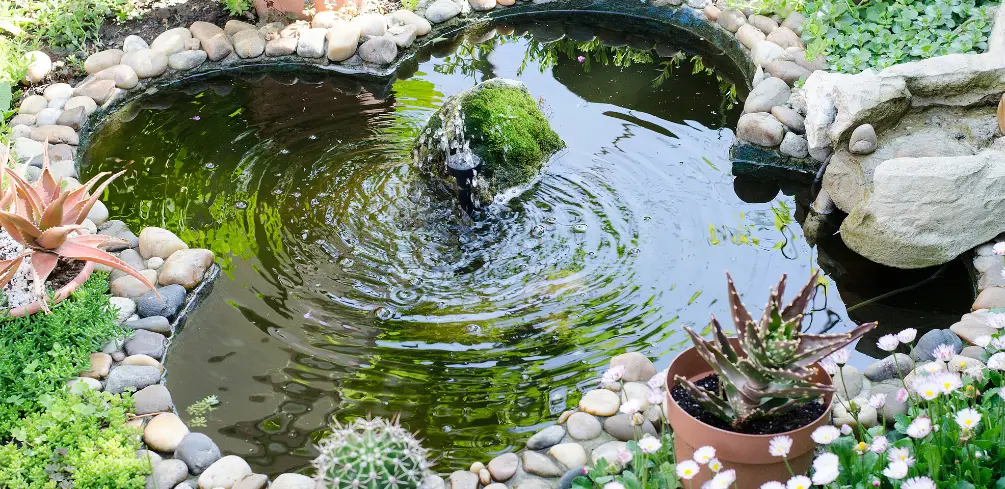Imagine the soothing sound of trickling water, the aesthetic appeal of a beautifully crafted fountain, and the peaceful ambiance it adds to your backyard.
But wait! What’s that green sludge creeping up on your serene oasis?
And those floating debris surely don’t belong there.
The sight might be disheartening but fret not because maintaining your backyard fountain’s cleanliness is simpler than you think.
Diving headfirst into this task may seem daunting, especially if algae have already started forming or murky waters are clouding its beauty. However, with regular maintenance and a few handy tips under your belt, you’ll be able to keep your fountain clean and clear throughout each season.
Whether it’s tackling algae growth or understanding the role of fountain pumps in keeping the water fresh, we’ve got you covered.
Regular Maintenance is Key For Fountains

You can’t underestimate the importance of regular maintenance when it comes to keeping your backyard fountain clean and functional.
Regular servicing doesn’t only ensure that the pump continues to work optimally but also significantly enhances fountain aesthetics.
A well-maintained fountain is a beautiful sight, with the sparkling water flow adding an elegant touch to your backyard. Over time, however, debris like leaves and dust can accumulate in the water and on your fountain, affecting its appearance and functionality.
Therefore, it’s crucial not just to wait until you notice these changes; proactive cleaning goes a long way in preserving your fountain’s charm.
Let’s dive deeper into how scheduled inspections play a vital role in maintaining your backyard fountain. During these inspections, focus on areas such as the pump filter or any other parts that are prone to clogging due to dirt buildup.
Check for algae growth, too – a common issue that tends to escalate if left unchecked over time.
Besides making sure every component is working correctly, regularly inspecting allows you early detection of potential problems before they become major issues—a clear example of prevention is better than cure.
Now let’s talk about what happens after inspection: action steps! If during your routine checkups, you spot any dirt or debris lodged in the nooks and crannies of your water feature, don’t delay – get rid of them promptly.
Ensure you scrub off any algae clinging onto surfaces using suitable cleaning agents available on market shelves.
Also, remember to switch off and disconnect power sources before starting this exercise for safety purposes.
For challenging cases where stubborn stains refuse to budge or when dealing with complex fountains structures, professional help might be necessary – so don’t hesitate to reach out!
By sticking to these practices religiously, rest assured that you will keep enjoying an outstandingly clean backyard fountain all year round.
Tackling Algae Growth On Fountains

Battling algae growth in your water feature isn’t exactly a walk in the park, but with regular maintenance, it’s not an insurmountable task either. The key is to be proactive rather than reactive.
Algae are natural organisms that thrive in any body of still water exposed to sunlight – including your backyard fountain.
However, their overgrowth can lead to clogged pump filters and unsightly green sludge that certainly doesn’t contribute positively to your garden aesthetic.
Here are a few steps you can take advantage of:
- Use algae inhibitors: These special chemicals hinder algae growth by altering the water’s chemistry, making it less habitable for these organisms.
- Regular cleaning: This involves scrubbing down the fountain surfaces and removing any visible algae using soft brushes or pads.
- Incorporate UV sterilizers: These devices kill or damage harmful microorganisms, including algae, in your fountain’s water through ultraviolet light exposure.
Remember, each backyard fountain has its own unique set of variables, such as size, material, location, amount of sunlight exposure, and so on, which will influence how you tackle this common issue.
Therefore, understanding these factors will help you determine what method works best for keeping algae at bay without causing harm to your fountain or any wildlife that might come into contact with it.
For instance, if you have fish or plants in your pond, opting for non-chemical methods like UV sterilizers may be a safer bet compared with using harsh chemical inhibitors.
You’re now equipped with some practical tips on combating unwanted algae growth; apply them consistently and watch your backyard fountain maintain its charm season after season!
Dealing with Debris and Murky Water

When it comes to dealing with debris and murky water in your prized water feature, don’t let this challenge steal your peace of mind.
The first step is understanding why the problem occurs. Debris can come from various sources like falling leaves, wind-blown dirt, or even wildlife interference.
These materials settle at the bottom of your fountain, causing the water to become cloudy over time. Murky water isn’t just an eyesore; it can also cause damage to your filtering systems if left unchecked.
Now that you understand what causes debris build-up and murky water, let’s delve into how to handle these issues effectively. Regularly skimming the surface of the fountain helps remove floating debris before it sinks and begins decomposing in the water.
A fine-mesh net is ideal for this task as it captures small particles that other tools might miss. As part of routine maintenance, drain and clean your fountain every few months, depending on its size and location.
This allows you to remove settled debris manually, which could clog up your filtering systems if ignored.
| Preventive Measure | Frequency |
|---|---|
| Skimming the Surface | Daily |
| Drain & Clean Fountain | Every 2-3 Months |
| Check Filtering System | Monthly |
| Control Wildlife Interference | As Required |
Lastly, consider incorporating natural deterrents or barriers against wildlife interference, such as bird nets or decoy predators, to keep birds away from bathing in or consuming from your fountain regularly – their droppings contribute significantly towards fouling up the waters too!
Also, ensure regular checks on your filtering system for any blockage signs – they are crucial in keeping both debris levels down and maintaining clear waters running smoothly through all seasons without fail!
Remember: prevention is better than cure when maintaining a beautiful backyard fountain free from debris and murky water.
The Role of Fountain Pumps

Let’s not forget it’s your fountain pump that plays a pivotal role in maintaining the charm of your water feature.
This is more than just a decorative element in your garden; it’s an essential tool to keep the water circulating and prevent stagnation.
Pump efficiency is key here because if your pump isn’t working properly, debris can accumulate rapidly and lead to murky water or even damage your fountain. Keeping an eye on the performance of the pump will help you maintain its efficiency for longer periods.
Listen for unusual noises or look for signs of reduced water flow – these could indicate that something’s amiss with your pump.
Regular cleaning also contributes significantly to pump efficiency. Detach the pump from time to time, disassemble it if necessary, and clean each part thoroughly using a soft brush and warm soapy water; this will remove any accumulated debris or algae that might hinder its performance.
Replacing an underperforming or broken fountain pump may seem like a daunting task but trust me; it’s easier than you think!
Remember, every machine has a lifespan, and pumps are no exception. If, after cleaning and checking, everything seems fine, but you’re still experiencing issues with the water flow or clarity, then it might be time for a pump replacement.
Choose one that matches your fountain size and specifications – installing an overpowered or underpowered unit will only create more problems down the line.
So go ahead – take care of that integral part of your beautiful backyard oasis!
Winter Care for Your Outdoor Fountain

As the chill of winter sets in, your outdoor fountain needs some extra love and attention to stand strong against the frosty onslaught. Water left in fountains can freeze, causing expansion that may lead to cracks or other damage.
To prevent this from happening, you need to consider a few steps for frost protection. You might think it’s a daunting task, but with proper planning and the right materials, it can be quite straightforward.
Here are some handy tips to protect your backyard fountain during winter:
Now let’s talk about maintaining pumps during cold months. Pumps are an essential part of any fountain, but they’re not designed to handle freezing temperatures.
So you should remove them before winter comes along. Once removed, clean them thoroughly using vinegar solution or appropriate cleaning agents and then store them indoors until spring arrives.
Don’t forget to seal any tubing as well because leftover water can freeze and damage it.
Remember that taking care of your outdoor water feature is not just about aesthetics—it’s also about prolonging its life and ensuring its performance for seasons to come.
These simple preventative measures will make sure that when warmer weather returns, you won’t have any unpleasant surprises waiting for you regarding your beloved backyard centerpiece.
Your efforts now will pay off later by saving you both time and money on potentially costly repairs due to neglecting proper winter care for your outdoor fountain.
Conclusion
In the end, it’s clear that ‘an ounce of prevention is worth a pound of cure.’ Keeping your backyard fountain clean doesn’t have to be a daunting task.
With regular maintenance, tackling algae growth, dealing with debris effectively, and understanding the role of fountain pumps, you’ve got all bases covered.
Don’t forget about winter care too! It’ll ensure your fountain stays in prime condition all year round.
After all, a clean fountain is not just aesthetically pleasing but also adds value to your home.





